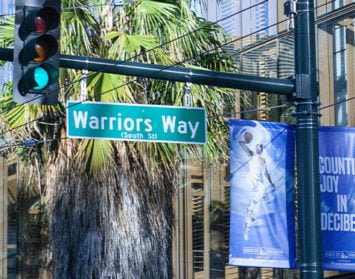How changing the way the game is played can revolutionize an industry.
By Jason Hughes
A Wall Street Journal article last month authored by Ben Cohen about the Golden State Warriors struck a chord with me. The premise was that the data-driven owners of the team felt there was an opportunity to exploit the three-point line as a market inefficiency. Then they built a team around doing just that.
Mr. Cohen states that, in the past, only 22% of the shots put up were 3-pointers. But the new team owners, with limited basketball experience, decided to rewrite the rules for how to run a basketball team. The data showed that NBA players made nearly the same number of shots from 23 feet as they did from 24 feet, but the “value” increased from .76 points to 1.09 points – a 43% increase in value – as a result of exploiting the three-point line!
The Warriors are breaking records and widely anticipated to win the championship again this year thanks in part to three-point phenom Stephen Curry. How was it that executives, with really no expertise in professional basketball, could see an opportunity when so many veterans working in the industry for decades missed it?
Or how about Takeru Kobayashi? He set a world record by eating 50 hot dogs at the 2001 Nathan’s Famous International Hot Dog Eating Contest – doubling the previous record. Mr. Kobayashi completely rewrote the way to excel at massive hot dog consumption, ultimately devouring 69 hot dogs in a later contest! By rethinking the best and most efficient way to eat hot dogs – in a gargantuan way – Kobayashi ate double what the others thought would be a winning amount. He separated the dog from the bun and scarfed them down separately. Brilliant!
Rewriting the Rules
For those of us not named Curry or Kobayashi, how do we apply the same unique thinking to rewrite the rules of our mostly antiquated industries?
Take the commercial real estate industry – it has done business nearly the same way for over 100 years. First, it was, and continues to be, set up to service landlords. Brokers help landlords buy their buildings, lease their buildings, manage their buildings, and ultimately sell their buildings. They do the same dance over and over, generating significant cash flow and profits from their clients – the landlords.
Second, most brokerage companies have found that it is cheaper to employ independent contractors (aka real estate agents, salespeople, and brokers) to work “independently” and then split the revenue stream. It eliminates the employer risk. These companies look for agents with a “sink or swim” mentality who can figure out how to do everything. They then provide as little operational support to their agents as possible, as that costs lots of money. They’ve found that resourceful agents have a way of servicing clients with nominal overhead — typical support is one admin per 8-to-12 agents.
Third, most of these brokerage companies have found that being landlords themselves is the most profitable business of all. Most of the public real estate brokerage companies have vast ownership holdings in buildings that they can buy, lease, manage and sell with no competition, so their fees are protected. They are highly incentivized to have a profitable experience, as that will boost their stock price and thereby their retirement portfolios. So the brokers who fill these buildings with tenants ensure the landlords (aka their bosses) always get the better end of the deal. Not a bad gig at all!
But what if you step back and re-evaluate the entire industry? What if you questioned who the ultimate client was, be it the landlord or the tenant?
Changing the Game
Hughes Marino did just that. Nearly 25 years ago, we questioned foundational assumptions about the commercial real estate industry. We determined that the industry should center on corporate tenants – the ones paying rent – not landlords. We felt that landlords were another service provider no different than the brokers, property managers, and janitors, who serve the same clients. Without the tenants to pay rent office buildings would not exist, just as without consumers to purchase clothes Nordstrom wouldn’t exist. Yet Nordstrom makes it clear that the consumer is the customer – not the other way around. Our industry has been slower to adapt.
If commercial real estate were the NBA then customer service would be our three-point line. Our company has revolutionized the level of service we provide to our clients, which in turn has paid huge dividends. We hire seasoned pros in all disciplines – actual employees, not just independent contractors – and provide deep operational support with a 2-to-1 admin to broker ratio. We have 30-year veterans who have worked on some of the most complicated real estate transactions in the state, as well as real estate attorneys, construction managers, and lease audit experts to round out the brokerage team’s capabilities. All told we are able to take care of our clients’ needs in a way that our sink-or-swim competitors simply can’t match.
Our belief is that, as a high-performing team of experts having total alignment with our clients – corporate tenants – we can provide better service than our competitors. We also avoid conflicts of interest by never representing landlords (or worse – being a landlord). I won’t compare us to the Warriors or Kobayashi, but our business has quadrupled and our clients often tell us “they wished they’d known us sooner!”
While we will always look for ways to improve our model in order to better serve companies with their real estate, I am proud to say that, as for office space brokerage, we’re changing the game.
This article first appeared in CSQ Magazine.
Jason Hughes is founder of Hughes Marino, an award-winning commercial real estate company with offices across the nation. A pioneer in the field of tenant representation, Jason has exclusively represented tenants and buyers for more than 30 years. Contact Jason at 1-844-662-6635 or jason@hughesmarino.com to learn more.











